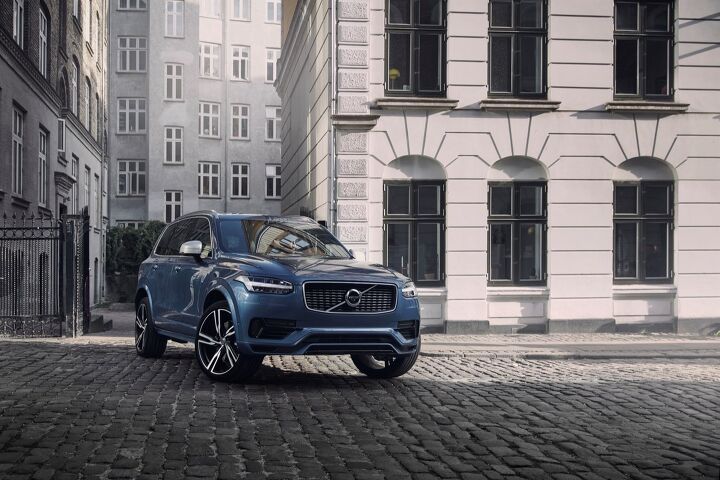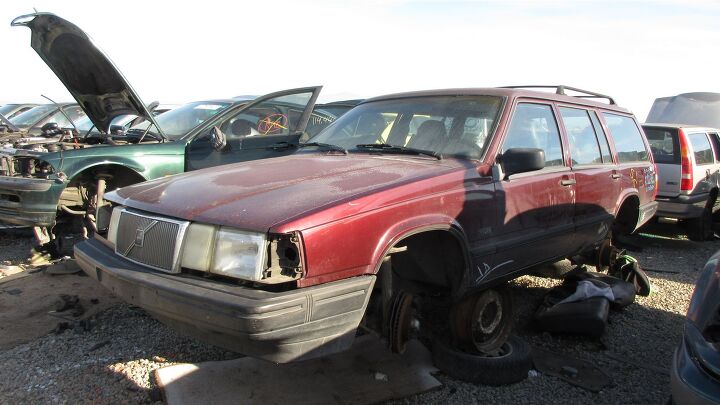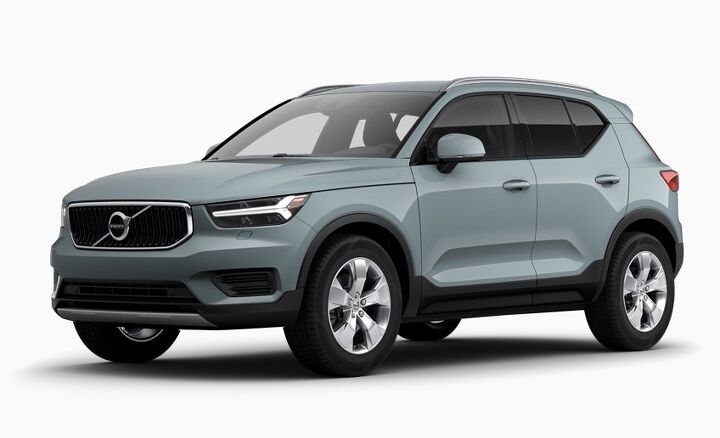#volvo
2018 Volvo XC60 T8 E-AWD Review - Silent Serenity
One of the downsides of doing this job is adapting to a new car every week. While the joy of never actually performing maintenance on your daily driver makes up for it, I struggle with basic tasks at times that should be second nature. Various cars have different locations for parking brakes, for example — I once stomped toward what I thought was a pedal-actuated parking brake, and instead caught my toe on the hood release.
That struggle extends to plug-in hybrids like this 2018 Volvo XC60 T8 — I simply forget to plug the darned thing in. Volvo quotes up to 17 miles of all-electric range. My commute to the office is right around 8 miles. I rather like the idea of not using a drop of gasoline to get to the day job, but two things conspired to keep me from that goal: my general idiocy, and the intoxicating torque supplied by this innovative powertrain.
Volvo's Already Shuffling Production to Avoid Tariffs
Unlike Volvo’s S90 sedan, which is built half a world away from its V90 wagon stablemate, the Chinese-owned Swedish automaker has some flexibility in where it sources its XC60 crossover. Two plants — one in China, one in Torslanda, Sweden — crank out the second-generation utility vehicle, but the U.S. market gets its full share from the Orient.
After the Trump administration imposed a tariff of 25 percent on Chinese-built vehicles, Volvo’s XC60 suddenly found itself dragging a financial anchor. Hardly a great situation for a model that outsold all other Volvos in the U.S. last month. To side-step the tariff, Volvo’s already making changes.
Say goodbye to the Chinese XC60.
Junkyard Find: 1993 Volvo 240 Wagon
Volvo made the beloved 240 for 19 model years, 1975 through 1993, and the car didn’t change much during that period. By the early 1990s, Volvo had “replaced” the increasingly dated-looking 240 three times, with the 740, 940, and 850, but plenty of buyers were still choosing the ancient brick over the more modern iron. It had to end at some point, though, and 1993 was the last year for these cars.
Here’s a very clean, very high-mile ’93 wagon in a Denver-area self-service yard.
Room at the Bottom: Volvo Crafts a New Entry-level XC60
Few will disagree that the second-generation Volvo XC60 crossover, which debuted for the 2018 model year, is a handsome vehicle. The midsizer adopts many of the styling decisions bestowed upon its larger XC90 brother, and that’s a good thing. Still, despite its smaller footprint, the XC60 remains a premium vehicle with a premium price.
For 2019, however, the entry-level XC60 sheds both content and price.
Volvo's XC40 to Be the Brand's First Electric Model
Electric, not electrified, as you can already find several Volvo models boasting a plug and a combination of gasoline and electric propulsion. The automaker best remembered for keeping the 240 in production with only minimal changes for two decades now wants to pin the technology pedal to the floor, setting a goal of having 50 percent of its customers drive away in fully electric vehicles by 2025.
Ambitious, to say the least. The first electric model would come along in 2019, the automaker stated earlier this year, while keeping the identity of the model under wraps. We now know it’s the XC40, which should comes as no shock to anyone.
Volvo Puts Pedal Down to Bring Next-generation, All-American Volvo XC90 to Market
The Chinese-owned Swedish brand’s first U.S. assembly plant, which is about to launch into production of the next-generation S60 sedan, will gain a second exclusive product in the form of the next-gen XC90.
As the priciest vehicle bearing a Volvo Cars badge, the XC90 remains a huge part of the brand’s — presence and profits — in the United States. And, when sole production of the model comes to the Southeast factory in just three years, workers will be tasked with building a model capable of Level 4 autonomy and all-electric driving. It’ll be a challenge, Volvo’s CEO says, but it’s necessary.
Trade War Watch: Volvo Worried About New U.S. Factory, Germans Want Tariffs Killed Entirely
The ground beneath the factory Volvo Cars opened Wednesday in South Carolina grew shakier after company executives warned that the U.S.-China trade dispute could undo plans to create up to 4,000 auto jobs in the state.
As you probably know, Volvo is currently owned by Chinese automaker Geely — which has a lot to lose if trade relations break down. Geely intends to export Volvo’s American-built cars to markets outside the United States. The situation’s a problematic one, as Volvo also imports the bulk of its U.S. market vehicles and any economic hurdles would surely gum up the works.
Volvo Doesn't Want You to Forget About the S60 Reveal on Wednesday
Volvo doesn’t want anyone to forget it’s revealing its first U.S.-built model on Wednesday, so it furnished us with a few more teasers to whet the collective appetite. It isn’t the car’s looks that have us excited, however — we already know the S60 will resembled a scaled-down S90 in both form and function.
What has our shorts in a pleasant knot is the fact that Volvo hasn’t replaced the model with another crossover. The new model replaces the second-generation sedan launched in 2010 (and sold in ever-decreasing numbers since 2012) and the automaker seems intent on offering everything customers have come to expect, and then some. There’s even a Polestar Engineered edition of the T8 model that offers 415 horsepower and 494 lb-ft of torque, plus enthusiast-oriented tweaks to the braking and suspension.
Frankly, it’s all shaping up rather nicely.
QOTD: Can You Build an Ideal Crapwagon Garage? (Part V: Coupes)
We’re strolling through the various sections of our Crapwagon Garage, and are just over halfway finished with this series (unless I can add extra vehicle segments without any hair-splitting). Each week we’ve scaled somewhat upward in either size or utility — hatchbacks came first, then sedans, trucks, and wagons. But in this fifth entry we pare things back down to cover the Crapwagon coupes of your dreams.
Now That the XC40's a Hit, Volvo Wants More Small Cars
Volvo, back from near death and feeling pretty pleased with itself, wants to capitalize on the modular platform found beneath the XC40 compact crossover. With 80,000 orders for the new-for-2018 ‘ute under its belt, the Chinese-owned Swede plans to spawn more models and reassert itself in the small car space.
On Thursday, the company said it would throttle up production of the XC40 at its Belgian assembly plant, which will soon boast quite a bit of usable space. The S60 sedan’s headed to South Carolina later this year. Meanwhile, the V60 wagon sibling will move most of its production to a Swedish plant.
What does this mean for the United States? Perhaps more than you’d expect.
Volvo Boss Predicts a Plug-in-filled Future, but Americans Don't Seem That Keen on the Brand's Largest Greenie
The second-generation Volvo XC90 announced the brand’s confident and triumphant return to the forefront of automotive discourse. With its parental troubles behind it, the 2015 model year XC90 arrived with dignified, upscale sheetmetal and served as a styling template for future models like the S90 and XC60.
It also heralded the brand’s move towards downsized powerplants assisted by electric motors.
The company’s CEO, Hakan Samuelsson, sees a not-too-distant future where plug-in hybrids make up a quarter of its sales — an attainable goal on a global scale, given China and Europe’s fondness for such models. In the United States, though, Volvo’s plug-in XC90 — lately, anyway — seems to be headed in the opposite sales direction as its plug-free model. Slightly odd, as plug-in hybrids are ascendent in America.
Rare Rides: The Volvo 480 of 1993, Which Doesn't Look Like a Volvo
Occasionally on the vast and wondrous expanse of the Internet of Cars, I’ll run across one of these uniquely shaped little Volvos. In past instances they were either not for sale, were lacking in condition, or had few available photos.
All that changed the other day, when I sought out a photo of the 480 to make a point on Twitter. Let’s check out this charcoal-colored box, shall we?
Lynk & Co Reveals New Model, Doubles Product Lineup
Lynk & Co, the Geely-owned sister brand to Volvo, is rounding out its product lineup with the announcement of a new sport utility vehicle. For clarification, it’s not really an SUV, as Lynk only builds car-based crossovers — and it’s also not entirely new, because it appears to be a squished-down version of the existing 01, itself based on the Volvo XC40. But this recipe may still have produced something novel for the fledgling automaker.
Based on claims from the manufacturer, what we have here is a shortened, lowered, and girthed-up sporting version of its existing crossover. Called the “02,” it’s an even more wagon-like CUV (that stops short of being a full-blown car). This makes sense, as the brand is already planning an “03” sedan. Spy shots of the sedan prototype reveals it more or less resembles an 01 “SUV” with a lowered ride height and different roof.
In fact, all of these vehicles look so similar that it almost feels like Lynk & Co is trying to pull a fast one on us. However, a critical eye reveals subtle styling cues that differentiate the models, even if it’s only slightly.
Junkyard Find: 1994 Volvo 940 Turbo Wagon
The Volvo 900 Series replaced the 700 Series, which replaced the 200 Series, but — in true Volvo fashion — there was sufficient production overlap between these related models that all three were available at the same time for a couple of years in the early 1990s. The 940 sold well in the United States, but you’ll see more 240s and 740s today, perhaps due to the great affection held by Volvo fanatics for the “real” rear-wheel-drive Swedes.
I went into a Northern California wrecking yard determined to shoot the first 940 or 960 I saw, and that car turned out to be this 940 Turbo station wagon.
Ace of Base: 2019 Volvo XC40
When the majority of the buying public thinks of Volvo, three things generally come to mind: safety, boxy wagons, and professors in tweed sport coats with those weird elbow patches. This is understandable, given that the company made hay selling safe and boxy wagons to professors in tweed sport coats with weird elbow patches.
Volvo has long since de-weirded itself but still marches to a slightly different Swedish beat. It’s currently under the stewardship of a Chinese company that gives the brand enough leash to generally do its own thing. Starting at $35,200, the automaker’s least-expensive car, the XC40, should help bring new buyers to the brand. Let’s see how it stacks up in base form.






























Recent Comments